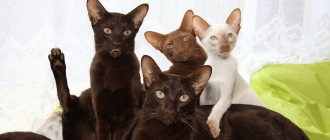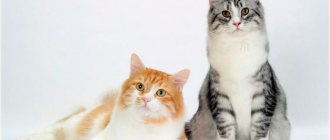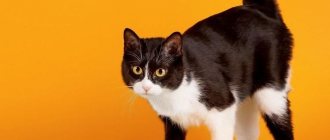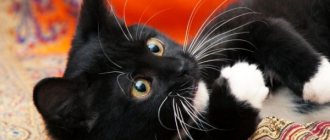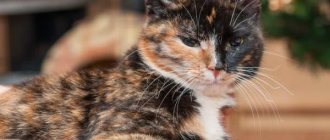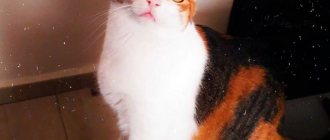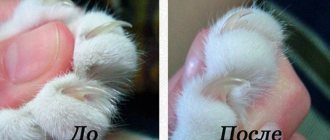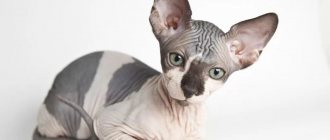History of the Oriental cat breed
Oriental cat
Genetically, oriental cats are close to the Siamese, with whom they began to be exported from Thailand in the 19th century. British breeders did not consider (or did not want to consider) green-eyed cats as an independent breed, so they classified them as a classic Siamese with a modified type of color. It is worth noting that at European exhibitions Orientals were not particularly favored, systematically disqualifying mustachioed emigrants either for non-standard colors or for the emerald shade of the iris.
The animals also did not arouse much interest among potential owners, so until the beginning of the 20th century, Oriental cats were bred only by enthusiasts who were passionate about breeding activities. The real crisis fell on the Thai Eared Cat in 1923, after the American Siamese Cat Club strictly tabooed the breeding of any variety of pets, with the exception of blue-eyed individuals with the Himalayan color.
For almost 30-odd years, Orientals were in limbo: they were expelled from the Siamese clan, but were never recognized as an independent breed. They remembered the cat only in the 60s by British and American breeders, who were carried away by the extreme appearance of animals. Initially, breeders planned to develop another variety of Siamese cat, which would have a uniform coat color, but would not lose the grace of its lines. To achieve this goal, Orientals began to be crossed with Abyssinians and other short-haired breeds.
1977 was a landmark year for Orientals, in which the wards of American breeders received their own standard of appearance. By the way, the first set of breed characteristics developed for overseas murkis was almost completely copied from the Siamese standard (with the exception of the points “body” and “colors”). But in Britain they were in no hurry to honor Asian cat breeds and spent 20 long years looking closely at them, scrupulously weighing the pros and cons. As a result, English long-eared cats were able to become an independent breed only in 1997, after official recognition by the GCCF.
Oriental cat with cat
Black oriental cat
How to choose the right Oriental pet, prices, where to buy
The cost of an Oriental kitten is determined individually by the nursery selling it, but on average it is at least 5 thousand rubles. The price is determined by a number of factors, including:
- compliance with breed standards;
- competition among breeders of this breed.
A kitten of this breed can be distinguished by its external features: triangular head shape, long neck and paws. The kitten especially has wide-set, slanted (non-round) eyes and very large ears, the growth of which stops when the kitten reaches 3 months of age.
An Oriental kitten can be distinguished by its large ears.
Oriental kittens should be purchased from professional nurseries. They provide for responsibility for his health, education, and socialization. The risk of purchasing a sick or non-purebred animal is minimal. Along with the purebred animal, its documents (metrics) from the official club of felinologists are provided. You need to pick up a kitten from the nursery after it turns 3 months old. At this time, he will have already formed the necessary immunity. The baby will have all his required vaccinations and is already accustomed to a scratching post and litter box.
Appearance of an oriental cat
Orientals are typical Asians: graceful, lean, with the hypnotic power of a jade gaze. A distinctive feature of these charismatic pussies is their phenomenal plasticity of movements, thanks to which even ordinary stretching in their performance turns into a full-fledged yoga master class. Based on their coat type, Oriental cats are divided into short-haired and long-haired. The latter variety was born in the 60s of the last century as a result of crossing a shorthaired Oriental with a Balinese (Balinese cat). The Oriental Longhair was introduced as an independent breed in 1977, but it was only able to confirm its worth at exhibition competitions in 1997.
Head
Oriental kitten
According to the standard approved by the WCF (World Cat Federation), the head of an Oriental must have a flat forehead and a prominent profile. The muzzle of representatives of this breed should be narrow, and the chin line should be clearly defined. A mandatory item is the wedge-shaped shape of the skull.
Nose
Elongated, smooth. Located approximately in line with the chin.
Eyes
Almond-shaped, slightly slanting. The distance between the eyes is visually equal to the length of one of them. Regardless of coat color, all Orientals have rich emerald eyes. An exception to the general rule are white-haired individuals, whose iris color may be blue. Some cats have heterochromia (different eyes).
Ears
Quite massive in relation to the head. The ear flap is thin and wide, continuing the wedge-shaped line of the cat's muzzle. The tip is slightly rounded. The most intensive growth of the ears is observed in the first months of the animal’s life, which is why the Oriental kitten resembles a hybrid of Cheburashka and Yoda from Star Wars.
Neck
Graceful, elongated type.
Oriental cat face
Torso
Slender, noticeably elongated in length, with a well-developed muscle corset. The constitution of the body is close to lean: the animals look elegant and graceful.
Limbs
Oriental longhair cat
Oriental cats have extremely long limbs, giving their silhouette a slight aristocracy and grace. The animals' paws are oval and relatively small.
Tail
Whip-shaped, very long, with a sharp tip. The thickness of the tail is the same along its entire length.
Wool
Oriental cats have virtually no undercoat, allowing the fur to softly outline the contours of the body. The hair of short-haired individuals is shiny, satin-type. Long-haired animals have thin, silky hair. Since representatives of the second type have hair that fits tightly to the body, its real length is partially “lost.”
Color
Curled up into a ball
What the breeding experts were most loyal to were the color options for Orientals. Today, this is one of the few cat breeds that has the right to almost any shade of all existing ones.
In order to systematize the “colors” of eared cats, their basic types were identified by felinological associations. In particular, modern Oriental cats can have coats of such colors as:
- lilac (lavender);
- blue;
- red;
- Havana (brown);
- cinnamon (cinnamon);
- faun (beige);
- ebony (black);
- cream;
- white.
The preferred tabby colors are merle, brindle, ticked and spotted.
Defects and disqualifying defects of the breed
Serious defects that spoil the aristocratic appearance of Oriental cats include strabismus, any shade of the iris except green, as well as protruding and clearly palpable cartilage in the sternum area. As for exhibition events, first of all polydacts, very small or too thin individuals and cats with kinked tails will not be allowed to attend. The list of defective pets includes animals with insufficiently strong hind legs, spots on the fur in the form of medallions, as well as cats that breathe through their mouth. In the long-haired variety of Orientals, a double coat with a well-developed undercoat may be a reason for disqualification.
Breed standards
Oriental cats have an unusual appearance; they cannot be confused with any other breed, even with the closely related Siamese, because:
- The head is a long narrow triangle. The eyes are located at a fairly large distance from each other, the head is literally covered with skin, and the bones of the skull are well defined. The line of the nose does not decrease, there are no bulges in the eye area. The nose is smooth, continues the line of the forehead without bends. In profile, the muzzle is sharp, wedge-shaped.
- The mouth is of medium size, the chin forms a straight line with the nose. The chin is small.
- The ears are large and wide, triangular in shape, but rounded, continuing the line of the head.
- The eyes are oval in shape, medium in size, slanted towards the nose, and set shallowly.
- The body is long, thin, the animals have well-developed muscles. The hips are narrower than the shoulders, the stomach is retracted. The neck and legs are long, the hind legs are higher than the front legs. The pads are oval-shaped, small.
- The tail is long and thin, with a pointed tip and long hair.
- The hair on the body is short and thin, without undercoat.
This breed appeared in Thailand, and the first mentions of Orientals can be found back in 1400.
The Oriental cat is a fit and very slender, agile representative of the shorthair cat. All his movements are smooth and soft; this cat breed is truly aristocratic and elegant. Siamos are not so beautiful and agile. At the same time, they weigh quite a lot due to their long, elongated body - up to 6-8 kg.
Siamese-Oriental cats can have many different colors (up to 42-45), here are the most popular:
- chocolate;
- black;
- white;
- lavender;
- blue;
- light brown (cinnamon);
- redhead
In any case, the eyes should only be green, and the coat should not contain uneven, black hairs. In addition to the usual single-color coat, Orientals may have spots or stripes.
Photos of oriental cats
Character of an oriental cat
If, when buying a baby Oriental cat, you expect to receive an arrogant sofa Buddha in the future, do not hope - the Asian mentality in these cats is sleeping soundly. Purebred Orientals are quite sociable and playful pets, madly in love with their owner. Eastern arrogance and detachment are absolutely not characteristic of them.
Oriental cat during play
Oriental cats are characterized by dog-like behavior. This means that wherever the owner goes, the “wool Yodas” will definitely attach themselves to the side to control his every step. Consider the fact that you will only dream of peace with these perpetual motion machines, jumpers and runners. Sofas for oriental cats are not a habitat, but a convenient springboard from which it is so convenient to “fly up” onto a closet, chest of drawers or cornice. Conquering heights, to which cats so selflessly devote themselves, brings with it inevitable destruction in the interior, therefore, if a vase broken by a pet can seriously spoil your mood, it is better not to get an oriental cat.
Oriental cats are inveterate gambling addicts, and this addiction cannot be treated, so buy your pet more wind-up mice, teasers and balls - let him have fun for his own pleasure. With age, Orientals do not lose interest in games, so even older individuals enjoy chasing candy wrappers and paper balls around the floor. Another characteristic feature of the breed is its burning curiosity. Oriental cats simply cannot stand secrets, no matter how insignificant they may be. The contents of any closed container are subject to thorough inspection, and slammed doors to another room are completely regarded as a military secret that must be revealed at all costs.
Skoda
Oriental cats are very dependent on human attention. They can hardly tolerate loneliness, so before buying a Thai long-eared dog, you should think carefully about who will stay with the pet while you are at work. As for the annoying meowing, which many owners of Orientals complain about, it really does occur, so the “talkativeness” of the breed will have to be taken for granted. But the timbre of the voice of these kitties is more pleasant than that of the same Siamese.
Most Oriental cats have a bright personality. For example, some individuals are not very friendly towards children, while others, on the contrary, treat the younger generation with great condescension. Orientals get along well with other cats. But they may experience a slight mistrust of dogs, which passes over time. According to experts, the green-eyed “Asian” should not be the only pet in the house, because the presence of other animals in the room helps him endure separation from his owner less painfully.
Oriental in the hands of the owner
Negotiation
Oriental cat character
Oriental cats are energetic and self-sufficient. They have a rather reserved character, they are not particularly affectionate, but they are very devoted to their owner and are incredibly afraid of loneliness. Orientals have a well-developed sense of independence, but at the same time they are attached to their owner.
Orientals love to run and play; they are a very curious breed. They will examine every thing in the house, open all the cabinets, and take out some things that are interesting to them. They cannot be raised using brute force - they are very sensitive animals.
Oriental does not tolerate moving or changing owners well. He doesn't like to go for walks and prefers to play at home. At the same time, representatives of this breed are quite talkative. There is a myth that Orientals have an unpleasant, harsh voice, but this is far from true. They often purr and purr, but can also meow loudly. Their voice is unusual, but not unpleasant.
Training and education
Walking an oriental cat on a leash
Orientals inherited from their Thai ancestors a lively, sharp mind and excellent learning abilities. In particular, it is easy to “train” a cat to fetch objects, as well as to carry out simple commands. As for the basics of etiquette, their pet will have to be instilled, because, despite the fairly high level of intelligence, oriental cats are capable of minor dirty tricks. For example, little eared cats love to swing on curtains and dig into flower pots. They do this not out of harm, but out of thoughtlessness, so it is very important to immediately point out to the kitten that such behavior is unacceptable.
Punishing, let alone beating, an animal is the last thing. An Oriental cat can easily guess about its own mistakes, relying only on the intonation of your voice, so use this quality to its full potential. Sternly shout at the mustachioed lawless man walking around the table and hiss expressively at the kitten climbing the curtains. You can be sure that the pet will intuitively understand what they want from him.
A common mistake that can negate the results of all your efforts is periodic exceptions to the established rules. As an example: today a serious reprimand has been given to the kitten jumping on the table, and tomorrow you are filming a video for YouTube where the tiny Cheburashka is briskly climbing the tablecloth to your encouraging comments.
Care
The Oriental's short, soft, black, gray or brown coat, which has no undercoat, looks clean for a long time, sheds rarely, does not tangle, and therefore does not require regular brushing.
You shouldn’t bathe your cat often, otherwise you can dry out the skin, and the black or other dark-colored fur will become faded. For brushing once a month, it is better to use a silicone brush.
The ears are wiped with veterinary ear lotion 2 times a month, making sure there are no black spots inside - a sign of a tick. The claws are shortened with a similar frequency using a nail clipper. The teardrops of the eyes are wiped daily with a napkin moistened with boiled water.
Oriental is an indoor breed that does not require walking. But if you want to walk your animal, then only on a leash in warm weather.
Maintenance and care
Oriental cats do not require any special or labor-intensive care. Thai long-eared cats prefer to take care of the cleanliness of their fur themselves, which, by the way, they do quite well. The owner just has to buy a rubber mitten to clean off loose hairs from the pet’s body during seasonal shedding. The same procedure can be carried out using an ordinary damp cloth: shedding wool easily sticks to damp matter. It is generally not recommended to bathe Orientals. An exception can only be made for an animal that is too dirty or for individuals preparing for an exhibition.
Sleepy kingdom
Cats have their ears cleaned no more than once a week. No special equipment is required for this procedure, except for a cotton swab and disinfectant lotion, which can equally well replace regular Vaseline. Regularly examine your pet's eyes, removing accumulated dirt and mucus with a cotton pad soaked in boiled water. Ideally, Oriental cats should also have their teeth brushed, but in practice, few owners want to participate in this painstaking process. If for some reason you are unable to treat your pet’s oral cavity, try to minimize the risk of plaque and tartar by purchasing dry food. Densely pressed “drying” croquettes do a good job of cleaning teeth and are quite capable of replacing a regular brush. For animals that eat wet canned food, you can buy special veterinary treats for dental plaque (sausages and bones for dogs are suitable).
Caring for an Oriental cat's claws begins with the purchase of a scratching post. But since the nail plate of representatives of this breed grows quite intensively, once a month they should have a “pedicure” session. Shorten the claw by no more than 2 mm, otherwise there is a risk of injuring your pet’s skin. If the cat actively resists during the process, it is better to involve an assistant in the matter and stretch out the “pleasure” for several days.
Orientals have one not very pleasant trait - they love to taste indoor flowers. If a green-eyed kitten of this breed appears in your home, it is better to remove Dieffenbachias, azaleas and other plants that are poisonous to cats from his field of vision. The same applies to open windows. For the gutta-percha “Asian”, falling out of them is a matter of a few seconds.
Feeding
You won’t be able to save money on buying industrial food with oriental: the digestive system of the lop-eared “Thais” is simply not able to properly digest the food from your table. So, in the case of food, the owner of an Oriental cat has only two options: treat the pet with wet canned food or transfer it to “drying”. By the way, cats themselves prefer the first option, while their owners are more focused on dry food, which is cheaper and lasts longer. If you want to please your pet, but not at the expense of your own comfort, try alternating between canned food and dry food. The only thing you shouldn’t do is mix both types of food in one feeding.
Within Temptation
Sometimes an eared cat can be pampered with natural products, for example, a piece of lean meat, fish fillet, or oatmeal with milk. But you shouldn’t organize such belly celebrations too often. Firstly, the pet will quickly get used to the treats, which can lead to a loss of interest in commercial food. Secondly, such gluttony leads to obesity, to which Orientals are already prone. The cat's daily menu should not be very varied, so that the animal is not tempted to eat in reserve. Choose a suitable type of premium food for your mustachioed friend (options for Siamese cats are suitable) and do not deviate from the set course.
Oriental merle cat
Note: you can determine how suitable a particular type of food is for a cat by the condition of its fur. A soft, glossy coat without signs of dandruff indicates that the diet has been chosen correctly.
To discourage your Oriental cat from overeating, always leave enough food in her bowl. It is undesirable to feed an animal on a schedule, since pets regard this as the threshold of a serious hunger strike and consume more food than they need.
For the normal functioning of all body systems, it is useful to mix vitamin-mineral complexes into the food of Orientals. In particular, calcium and taurine supplements are recommended for young individuals. And of course, do not forget to provide the animal with round-the-clock access to clean water.
Toilet
Orientals are very smart and clean cats. Usually 3-month-old babies from the nursery already know what a tray is and how to use it correctly. If the kitten stubbornly continues to walk past the toilet, it is important to understand that he is not doing this out of harm. The tray may be in the wrong place. For example, if the toilet is located in the bathroom, the animal may be irritated by the smell of household chemicals.
It is better if the tray is in a secluded corner where no one will see the baby and where he can truly relax. A kitten sitting down to relieve itself in the wrong place must be frightened, but this should be done in such a way that the animal does not understand that the source of the threat is the owner. For example, you can clap your hands loudly, spray the Oriental cat with water from a spray bottle, or throw some kind of soft toy at it.
Catering
The main requirement for food is its balance.
Recommended food
If you are a busy person, then it will be easier to feed your pet with industrial ready-made food. They are conventionally divided into 4 groups: holistic, super premium food, premium food and economy class.
Holistics
Holistics are more expensive than others, but they are also better in composition. They do not use synthetic preservatives, wheat flour, corn, or vegetable protein ingredients. Contains only the best: fresh and dehydrated fish fillets, meat; peas, rice and lentils as sources of protein, and dried vegetables and fruits as sources of fibre. In addition to the above, there are also vitamin and mineral supplements. Examples of holistic feeds: AATU, Farmina N&D, Now Fresh.
Super premium class
Super premium food is somewhat lower in quality and the price of the product is noticeably lower. Ingredients: a good vitamin and mineral supplement, natural preservatives, while the percentage of meat ingredients is lower, as well as fewer sources of carbohydrates. Examples: Leonardo, Duke's Farm, Pronature Original.
Premium
Advantages of premium food: natural additives; low price; more meat than in cheap analogues; There is food for both kittens and adult cats, as well as for animals with diseases. Disadvantages: rather low meat content; a large proportion of plant components; the presence of dyes and flavors. Examples: Brit Premium, Royal Canin, Pro Plan.
Economy
Economy line food is bought by people who either cannot allocate a certain amount to feed a cat, or who do not know the truth about them. Their only advantage is their low price, but there are many more disadvantages! Firstly, the basis is corn and cereals, and exact descriptions and percentages are not indicated. Secondly, dyes and flavor enhancers are used. And finally, thirdly, these foods are poor in protein.
Below are recommended premium and holistic foods; links with food names are clickable. Using them, you can, within our website, read descriptions of food and read reviews from owners of the Oriental cat breed.
| Super premium | Premium | Holistic |
| Meowing Heads | Science Plan | Carnilove |
Natural products
If your choice is natural nutrition, consider the following.
Orientals love to eat, but are prone to being overweight. The permissible daily calorie intake for cats is 300 kcal, for females – 250 kcal. Babies up to 2 months are fed at least 5 times a day, from 2 to 4 months - 4 times, from 4-6 months - 3 times, over six months - in the morning and in the evening. Food should be at a comfortable temperature: not hot, but not from the refrigerator.
Be sure to include in your diet:
- Beef, lamb or rabbit: 3-4 times a week, 100-120 g;
- Chicken meat: every day;
- By-products (stomachs, heart, liver, chicken necks), minced: 1-3 times a week;
- Fish (trout, cod, salmon, hake, salmon): once a week for cats and 1-2 times for cats;
- Milk (boiled): for kittens up to 3 months, pregnant and lactating cats;
- Egg yolk, whole quail egg: 2 times a week.
- Porridge (rice, oatmeal, buckwheat, wheat): daily;
- Liquid semolina porridge - for kittens up to 3 months;
- Fermented milk products (low-fat cream, cottage cheese, sour cream, natural yogurt, kefir): possible every day;
- Cheese (unsalted): once a week;
- Boiled or fresh vegetables (beets, carrots, cauliflower, cucumbers, green beans): 4-5 days a week;
- Sprouted wheat grains, spinach, salad: 2 times a week;
- Brewer's yeast (dry): 3-4 times a week;
- Vegetable oil (half a teaspoon per porridge): every other day;
- Special supplements with vitamins and minerals: as recommended by a veterinarian.
The cat should always have access to fresh and clean drinking water. Do not pour tap water that is cold or contaminated. Change the liquid 2 times a day: morning and evening.
Oriental cats should not be given:
- Pork, lamb, duck and geese meat;
- Chicken bones, fish bones;
- Sweets: chocolate, marmalade, marshmallows, honey, cakes, etc.;
- Salt, spices, sauces;
- Baked goods (bread, cakes, pastries, etc.); human canned food and sausages;
- Smoked, salty, sweet dishes;
- Potatoes, soybeans, beans (with the exception of asparagus); human vitamins and supplements.
Photo of an oriental breed cat during rest hours)
Health and diseases of Oriental cats
Handsome men
Despite the fact that the average life expectancy of Orientals is 15-17 years, they cannot be called real big guys. By inheritance from Siamese ancestors, cats have inherited a whole set of genetic ailments that significantly complicate their lives. Many individuals are diagnosed with liver amyloidosis, which, if not treated promptly, can cause liver failure. Another scourge of the breed is myocardial disease (dilated cardiomyopathy), so the animal must undergo ultrasound diagnostics at least once every six months.
Eye problems among Oriental cats are also quite common. Most often, “Thais” suffer from strabismus and progressive retinal atrophy. In addition, there is always a risk of kittens being born with flat chest syndrome. If the disease is not recognized and treated in time, the baby’s lungs will not be able to work at full capacity, and he will simply suffocate.
Cinnamon and the faun
The cinnamon color of the Oriental cat is a warm brown, dark sand. This is the color of cocoa, chocolate - warm, not cold like “Havana”. The nose of such a cat will be brown, pink-brown, and the shade of the paw pads will vary from pink to brown.
Photos of cinnamon (cinnamon) orientals:
Fawn is a fawn color with a warm pinkish highlight. If it turns gray, blue or cold pink, this is already a non-compliance with the standard. Faun is softer, gentler than lilac. The color also looks a little lighter. Such a cat's nose, eyeliner and paw pads will be pinkish-fawn.
Photos of oriental cats of the “fawn” color:
How to choose a kitten
When buying an Oriental breed kitten, be sure to ask about its age. Nurseries that value their own reputation do not sell animals that are under 3 months old. When assessing the conditions in which babies are kept, pay attention to whether the breeder has cages in which unscrupulous sellers often lock their charges. Experienced specialists who love their work raise kittens in a home environment: they play with them, they are not put in an enclosure and are not limited in communication with other pets. Accordingly, such individuals will undergo socialization faster.
Oriental kittens with mother
Its appearance will also help to assess the health of an Oriental kitten. Eared cats with matted fur, discharge from the eyes and nose, and bloated bellies will bring nothing but problems. Any kitten purchased from a cattery must have a metric or pedigree. If there are none, then, most likely, under the guise of a purebred Oriental, they are trying to give you a mestizo. Sometimes breeders explain the lack of documents for a kitten as an unplanned mating, although this is nothing more than excuses and attempts to hide the truth about the true origin of the animal.
Those who plan to breed their pet in the future and get offspring from it should look into nurseries that sell breed-class oriental cats with impressive pedigrees. If you do not intend to breed kittens for sale, visit places where they breed orientals without breeding rights. Most of these nurseries offer already castrated or sterilized kittens.
Some breeders have a negative attitude towards early sterilization, which can seriously affect the external parameters of the cat, and do not carry out this procedure. In this case, all responsibility for the reproductive function of the pet falls on the future owner. Usually, before the sale, the buyer signs an agreement according to which he undertakes to spay/neuter the kitten as soon as it is 8-12 months old.
Pros and cons of the breed
Orientals have their advantages and disadvantages. Before purchasing such a kitten, it is worth studying them. The advantages of Asians are:
- unusual appearance;
- active, flexible, cheerful;
- the unusual shape of the muzzle is the main distinguishing feature of the breed;
- developed mind;
- training ability;
- high ability to communicate with people;
- there are no special conditions of care and care;
- affectionate and gentle;
- hypoallergenic.
The disadvantages of the Oriental breed are:
- touchiness;
- require a lot of attention from the owner;
- it is necessary to arrange an active lifestyle;
- They cannot tolerate cold or even relative coolness; the optimal room temperature for it will be 22-24 C.
Only by weighing all these features can you decide how well this breed suits the preferences and wishes of a particular person. If you like to spend a lot of time with your pet, play with it, caress and stroke it, then such an animal is completely suitable.
Save article:
Oriental cat
- a creature of exceptional beauty and unique appearance. The breed, closely related to the Siamese, is extremely promising not only because of its bright oriental appearance, but also because of its intelligence, grace and pleasant sociable character.
Adults like a cat’s friendliness, younger family members can appreciate its playfulness, and everyone, without exception, likes the cat’s emotional response to the owner’s caresses.
Since an Oriental cat can have both short and long hair, before getting a pet, you should learn about the rules of care - the kitty should be comfortable in the house.


